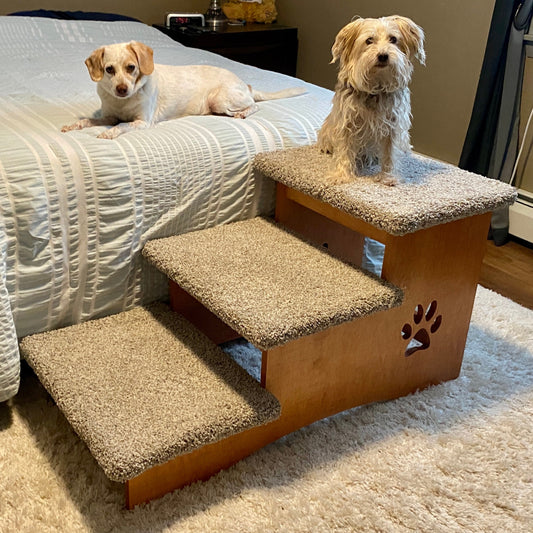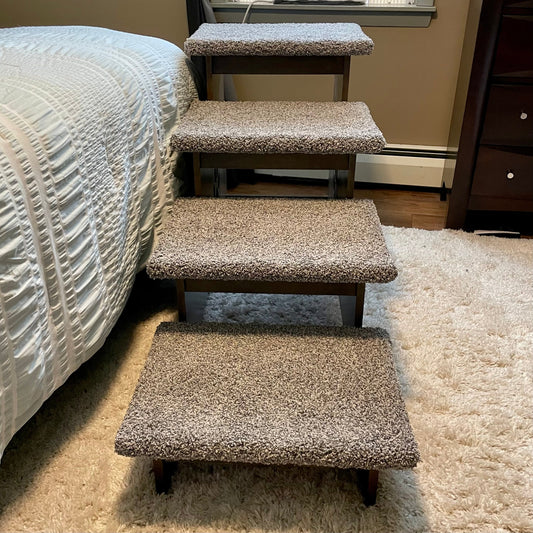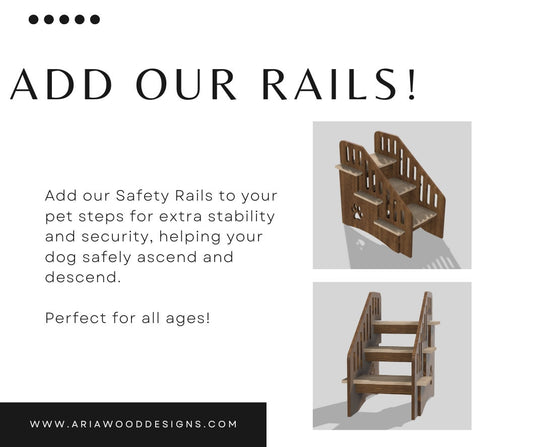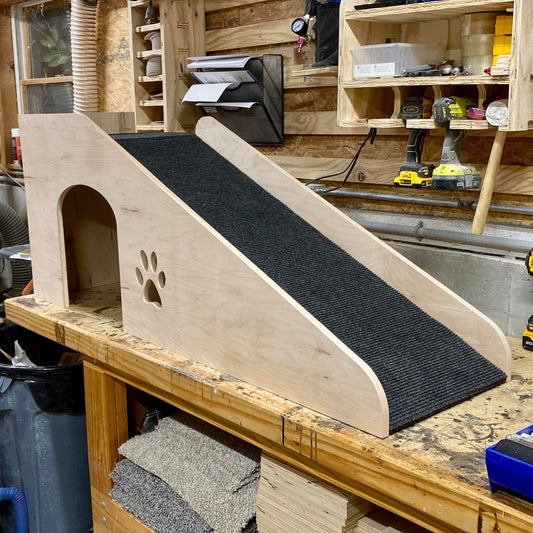Every pet owner knows the heartbreak of watching their beloved companion struggle to reach their favorite spots. Maybe it's your aging golden retriever hesitating before the couch, or your corgi staring longingly at your tall bed. This struggle isn't just about convenience—it's about maintaining your pet's independence, comfort, and joint health throughout their life.
Dog stairs and pet steps have become essential accessories for millions of households, transforming the way our furry friends navigate elevated surfaces. From protecting growing joints in puppies to supporting senior dogs with arthritis, these mobility aids offer practical solutions that enhance the quality of life for pets of all ages and sizes.
This comprehensive guide explores everything you need to know about dog stairs, from understanding when your pet needs them to choosing the perfect design for your home and lifestyle.

Understanding When Your Dog Needs Stairs
Recognizing the right time to introduce pet steps can make a significant difference in your dog's comfort and health. Several factors indicate when these mobility aids become beneficial or necessary.
Age-Related Changes
Senior dogs often develop mobility challenges that make jumping difficult or painful. Arthritis, hip dysplasia, and general joint stiffness can transform once-effortless leaps onto furniture into sources of discomfort. Dogs typically begin showing signs of reduced mobility around seven to eight years old, though this varies by breed and size.
Size and Breed Considerations
Small breeds like Chihuahuas, Corgis, and Dachshunds face unique challenges due to their short legs and long backs. These dogs are particularly susceptible to spinal injuries from repeatedly jumping on and off high surfaces. Large breeds, while naturally better jumpers, can benefit from stairs to reduce stress on their joints, especially as they age.
Recovery and Health Conditions
Dogs recovering from surgery, injuries, or dealing with chronic conditions like intervertebral disc disease may require temporary or permanent assistance reaching elevated surfaces. Pet steps provide a gentle alternative to jumping during healing periods and can prevent re-injury.
Preventive Care
Many veterinarians recommend introducing dog stairs early as a preventive measure. This approach helps maintain joint health over time and teaches pets to use stairs before mobility issues develop.
Types of Dog Stairs and Pet Steps
The market offers various styles of pet mobility aids, each designed to address specific needs and preferences.
Traditional Pet Steps
Standard dog stairs feature multiple steps leading to the desired height. These typically include three to five individual steps with adequate depth for comfortable paw placement. Traditional steps work well for most dogs and provide the most natural climbing motion.
Dog Ramps
Pet ramps offer a gradual incline rather than distinct steps. These work particularly well for dogs with severe mobility limitations or those hesitant to use stairs. Ramps require more floor space but provide the gentlest transition to walk onto elevated surfaces.
Folding and Portable Options
Compact designs fold for easy storage and transport, making them ideal for travel or homes with limited space. These lightweight options typically sacrifice some stability for portability but work well for smaller dogs.
Storage-Integrated Designs
Some pet stairs incorporate hidden storage compartments, serving dual purposes in homes where space efficiency matters. These designs typically feature sturdy construction to support both pet weight and stored items.
Key Features to Consider
Selecting the right dog stairs involves evaluating several critical features that impact safety, durability, and user experience.
Height and Step Depth
Measure the exact height from the floor to the target surface to ensure proper sizing. Step depth should accommodate your dog's paw size comfortably—deeper steps work better for larger breeds, while smaller dogs can navigate narrower steps more easily.
Weight Capacity and Stability
Choose stairs rated well above your dog's current weight to ensure safety and account for potential weight changes. Look for wide bases and non-slip feet that prevent sliding during use.
Surface Materials and Traction
The step surface should provide adequate grip to prevent slipping. Carpeted surfaces offer excellent traction and comfort, while textured materials can work for dogs who prefer harder surfaces. Avoid completely smooth surfaces that become slippery when wet.
Construction Quality
Solid wood construction typically offers superior durability compared to particle board or plastic alternatives. Look for reinforced joints and quality hardware that can withstand regular use without loosening or breaking.
Safety Features
Side rails or barriers can provide additional security for dogs who feel uncertain using stairs. Non-toxic finishes and smooth edges prevent injuries during use.

Benefits of Dog Stairs for Your Furry Friends' Health
Investing in quality pet steps offers numerous health advantages that extend beyond simple convenience.
Joint Protection
Regular jumping places significant stress on your dog's joints, particularly the hips, knees, and spine. Stairs distribute this impact across multiple smaller movements, reducing cumulative damage over time. This protection proves especially valuable for breeds prone to hip dysplasia or other joint conditions.
Maintaining Independence
Dogs derive significant psychological benefits from maintaining access to their favorite spots. Stairs allow pets to continue enjoying elevated perches without relying on human assistance, supporting their mental well-being and confidence.
Injury Prevention
Falls from furniture can cause serious injuries, particularly in older dogs with reduced coordination. Pet steps eliminate the risk of awkward landings that might result in sprains, fractures, or soft tissue damage.
Supporting Recovering Pets
During post-surgery, pets can feel confident and comfortable using the dog steps to provide controlled movement that promotes healing while preventing setbacks from inappropriate activity levels.
Choosing the Right Size and Style
Selecting appropriate dog stairs requires careful consideration of your pet's specific needs and your home environment.
Measuring Your Pet
Consider your dog's shoulder height, leg length, and overall mobility level. Smaller dogs typically need steps with rise heights between 4-6 inches, while larger breeds can handle 6-8 inch rises comfortably. Measure your dog's stride length to ensure adequate step depth.
Assessing Your Space
Evaluate the available floor space around the target furniture. Stairs require more room than many owners initially realize—plan for adequate clearance that allows comfortable approach angles without crowding the area.
Matching Your Décor
Modern pet stairs come in various wood finishes and carpet colors that complement home décor. Choosing attractive stairs encourages consistent use and maintains aesthetic appeal in living spaces.
Considering Multiple Locations
Many households benefit from stairs in multiple locations—bedside for nighttime access, living room for couch access, and potentially vehicle stairs for car entry. Plan for your dog's complete mobility needs throughout your home.
Materials and Construction Quality
Understanding construction differences helps identify stairs that will provide long-term value and safety.
Wood Types and Durability
Solid hardwood offers superior strength and longevity compared to particleboard or MDF alternatives. Plywood construction with veneer edging provides an excellent balance of durability and cost-effectiveness. Avoid stairs made from particleboard, which can deteriorate quickly with regular use.
Joinery Methods
Pocket-hole joinery creates exceptionally strong connections that resist loosening over time. This construction method distributes stress across multiple points, preventing failure at individual joints. Look for stairs that use mechanical fasteners rather than just glue for critical connections.
Finish Quality
Pet-safe finishes protect wood while providing easy cleaning. Water-based polyurethane finishes offer durability without harmful fumes. Avoid finishes that might chip or flake, creating potential ingestion hazards.
Carpet Selection
Pet-friendly carpeting should resist stains, odors, and excessive wear. Look for carpets with good traction properties that won't become slippery when slightly damp. Removable carpet allows for replacement if needed without discarding the entire stairs.

Training Your Dog to Use Stairs
Successful stair introduction requires patience and positive reinforcement techniques.
Initial Introduction
Start with the stairs positioned at ground level, allowing your dog to explore and become comfortable with the structure. Use treats and praise to create positive associations with the stairs before attempting to use them for elevation.
Gradual Height Increase
If possible, begin training with a single step or lower height target before progressing to full-height stairs. This builds confidence and allows your dog to understand the concept without feeling overwhelmed.
Positive Reinforcement
Reward every successful interaction with treats, praise, and affection. Never force or rush the training process, as negative experiences can create lasting hesitation around using stairs.
Consistency and Patience
Some dogs adapt immediately, while others need weeks to become comfortable. Maintain consistent training sessions and avoid removing stairs during the learning period, even if progress seems slow.
Maintenance and Care
Proper maintenance ensures long-term functionality and hygiene.
Regular Cleaning
Vacuum carpeted surfaces regularly to remove pet hair and debris. Spot-clean stains promptly to prevent permanent discoloration. Use pet-safe cleaning products that won't create harmful residues.
Structural Inspection
Periodically check all joints and fasteners for looseness or wear. Tighten hardware as needed and inspect for any developing cracks or damage that might compromise safety.
Carpet Replacement
Plan for eventual carpet replacement as part of normal maintenance. High-quality stairs should allow carpet removal and replacement without structural damage.
Storage Considerations
If stairs fold or disassemble for storage, ensure all mechanisms function properly and store components in a way that prevents damage.
Special Considerations for Different Life Stages
Pet mobility needs change throughout a dog's life, requiring different approaches at various stages.
Puppies and Young Dogs
Young dogs benefit from early stair introduction as preventive care and training. However, avoid overuse during rapid growth periods when joints are still developing. Focus on building positive associations rather than intensive use.
Adult Dogs
Healthy adult dogs can use stairs regularly without restriction. This life stage is ideal for establishing consistent stair use patterns that will benefit joint health long-term.
Senior Dogs
Older dogs may need additional encouragement and support during stair use. Consider adding side rails or using lower-rise steps for dogs with advanced mobility limitations. Monitor for changes in ability and adjust accordingly.
Dogs with Special Needs
Pets with specific medical conditions may require customized solutions. Work with your veterinarian to determine appropriate mobility aids and any usage restrictions.
Integration with Home Design
Modern pet stairs can enhance rather than detract from home aesthetics.
Color Coordination
Choose wood finishes and carpet colors that complement existing furniture. Many manufacturers offer multiple finish options that match popular furniture styles.
Space Planning
Position stairs to maintain clear traffic patterns while providing easy pet access. Consider storage options that keep stairs accessible but not intrusive when not in use.
Multi-Functional Designs
Stairs with integrated storage serve dual purposes, making them more acceptable in space-conscious homes. These designs often feature lift-top storage compartments for pet supplies or other items.
Making the Right Investment to Support Dogs' Health
Quality pet stairs represent a significant investment in your pet's long-term health and comfort.
Cost Considerations
While premium stairs cost more initially, they typically provide better durability, safety, and aesthetic appeal. Consider the cost per year of use rather than just the upfront price when evaluating options.
Warranty and Support
Look for manufacturers who stand behind their products with meaningful warranties and customer support. This indicates confidence in construction quality and commitment to customer satisfaction.
Long-Term Value
Well-constructed stairs should last throughout your pet's lifetime and potentially serve multiple pets over many years. Factor this longevity into your purchasing decision.

Aria Wood Designs | Dog Stairs and Ramps
When it comes to combining functionality with aesthetics, AriaWood Designs offers premium dog stairs and ramps crafted to meet the diverse needs of pets and their owners. Designed with durability and safety in mind, their products are made from high-quality wood, ensuring a stable and long-lasting mobility aid for pets of all sizes. The non-slip surfaces provide optimal traction, reducing the risk of accidents while climbing or descending.
What sets Aria Wood Designs apart is its dedication to blending practicality with elegant design. Each piece is carefully handcrafted to complement your home décor, offering a stylish alternative to traditional plastic or foam options. Ideal for small breeds, senior dogs, and pets recovering from injuries, these stairs and ramps provide an easy and comfortable way for pets to access beds, couches, or vehicles.
Visit Aria Wood Designs to explore their collection and find the perfect solution to upgrade your pet's mobility in style.
Enhancing Your Pet's Quality of Life
Dog stairs represent more than simple mobility aids—they're tools that preserve independence, prevent injury, and maintain the bond between pets and their favorite spaces. From protecting puppy joints to supporting senior dogs with arthritis, quality pet steps offer benefits that extend far beyond their initial cost.
The key lies in selecting stairs that match your pet's specific needs while integrating seamlessly into your home environment. Consider your dog's size, age, and mobility level alongside your space constraints and aesthetic preferences. Quality construction, appropriate sizing, and proper training create the foundation for years of safe, comfortable use.
Whether your furry friend needs help reaching a tall bed, accessing a favorite couch, or maintaining independence during recovery, the right pet stairs can transform daily challenges into effortless transitions. The investment in quality mobility aids pays dividends in preserved joint health, prevented injuries, and continued companionship in all the places that matter most.









